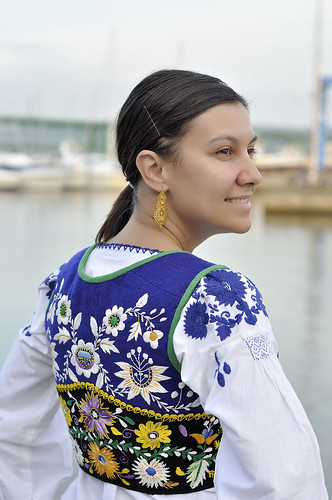Viana do Castelo embroidery (named after a town in the Portuguese Minho region) as we know it was born in the beginning of the XXth century. Before that there was a tradition of beautifully embroidered women's costumes worked by peasant needlewomen.
 |
| Traditional Viana's Costume, by Rui Silva |
In 1917, Gemeniana de Abreu e Lima gathered some of those embroideries and adapted the patterns used to suit the home, with main focus on the tablecloths, aprons, curtains… She organized an exhibition showing these peasant embroideries that was a true success and many attribute this moment to the birth of modern Viana do Castelo embroidery.
 |
| Gemeniana de Abreu e Lima, in 1917. Photo from CEBVC |
These were times of war, the First World War, and many women were alone with their children while the men were fighting. And Germeniana had this in mind when she began this work that soon obtained broad recognition even abroad. Some years later there was already a vigorous embroidery industry.
The embroidery of Viana became a source of income for many families in the rural areas – and in urban areas too. The companies distributed the pieces and threads by embroiderers, usually women living in villages near the city of Viana do Castelo. The embroiderers executed the embroideries in their own homes, occupying the remaining time from their other activities, often working for different companies. When the work was done, the embroiderers went to town, where they delivered to those who ordered.
In her isolation, the Minho woman transmitted joy, love and feeling to personal and daily use objects, like the costumes that characterize this region or the cloths that cover their tables. These peasant women beautifully combined embroidery as an earning source and the pleasure of creating art, in the long evenings of the village, in the sunny days of spring sunshine or in the soothing shadows of warm summer afternoons.
 |
| Old postcard representing Viana embroiderers, from here |
I loved getting to know this woman that in a time of crisis was able to bring to light the amazing ability of other women and create something new and beautiful. And I also loved to know how peasant women adapted their art and creativity to new demands... I believe that nowadays we would call it "innovation"...
These days we are facing a severe crisis in Portugal and we need many more of both of these kinds of women... I hope this may be an inspiration to them!!
I was almost forgetting our Portuguese class... Today it's difficult to choose the words... I'll choose the words that I read more often to characterize the work of these women: beauty and artistic sense... "beleza" and "sentido artístico"...
* I wrote this post after reading the books I've already talked about in my other posts, here and here and this document about Viana do Castelo embroidery.




Beautiful story. I adore people who manage to support others by showing what marvellous skills they actually have and can make use of for a living.
ReplyDeleteI found a quite similar story settled in India a while ago. The video really is worth watching: http://www.youtube.com/watch?v=0OGZ2yRNgdw&feature=context-chv